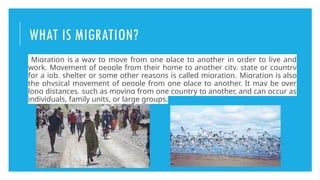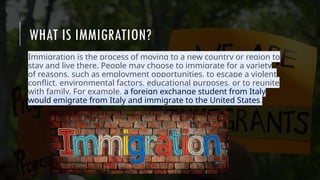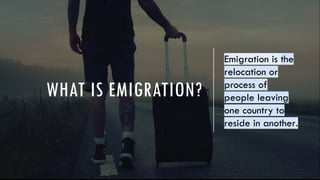MIGRATION presentation for class VI - travel
- 2. MAIN COUNTRIES WE ARE TAKING - ’üČ India ’üČ Canada ’üČSwitzerland ’üČUnited States
- 3. WHAT WE WILL DISCUSS - What is migration? - How can we stop this? - Is it a process or a problem? - Timeline of Migration - Why is it happening? -Who is a migrant? - Types of migration - do we still migrate for food? - What do you mean by immigration? - what is emigration? - History of migration - Causes of migration - How are people migrating? - Difference between migration, immigration and emigration?
- 4. IS IT A PROCESS OR A PROBLEM? Migration is a demographic process that moves people between places, and so contributes to population change with fertility and mortality. Migration is also a problem because it causes population redistribution within a country, particularly contributing to urban growth.
- 5. WHAT IS MIGRATION? Migration is a way to move from one place to another in order to live and work. Movement of people from their home to another city, state or country for a job, shelter or some other reasons is called migration. Migration is also the physical movement of people from one place to another. It may be over long distances, such as moving from one country to another, and can occur as individuals, family units, or large groups.
- 6. WHAT IS IMMIGRATION? Immigration is the process of moving to a new country or region to stay and live there. People may choose to immigrate for a variety of reasons, such as employment opportunities, to escape a violent conflict, environmental factors, educational purposes, or to reunite with family. For example, a foreign exchange student from Italy would emigrate from Italy and immigrate to the United States.
- 7. WHAT IS EMIGRATION? Emigration is the relocation or process of people leaving one country to reside in another.
- 8. CAUSES OF MIGRATION Some people move in search of work or economic opportunity, to join family, or to study. CAUSES OF IMMIGRATION Include higher wages, better employment opportunities, a higher standard of living, and educational opportunities. CAUSES OF EMIGRATION Some people move to travel the country or explore things.
- 9. INDIA
- 10. WHY IS IT HAPPENING? (IN INDIA) economic difficulties like poverty, low productivity, and joblessness serve as push factors and make people want to leave where they are currently living, for example, farmers in Maharashtra facing low yields due to recurring droughts might migrate to cities like Pune or
- 11. INDIAN HISTORY OF MIGRATION By some 70-50,000 years ago only a small group, of possibility as few as 150 to 1,000 people, crossed the Red Sea and traveled along the coastal route around the coast of Arabia and Persia until it reached India, which appears to be the first major setting point. India started migrating almost 65,000 years ago.
- 12. WHO MIGRATED FIRST IN INDIA? The first Indian migraters were African hunter-gatherers. They came over 50,000 years ago to the Indian subcontinent. India migrated toŌĆ” As of 2020, the united Arab emirates had the highest number of Indian migrants at around 3.5 million, the highest across the world. There are around 18 million Indian migrants across the world.
- 13. WHAT IS THE MIGRATION OF ANCIENT INDIA? The Indo-Aryan Migration (1800-1500 BCE) Foreigners from the north are believed to have migrated to India and settled in the Indus Valley and Ganges Plain from 1800-1500 BCE. The most prominent of these groups spoke Indo- European languages and were called Aryans, or ŌĆ£noble peopleŌĆØ in the Sanskrit language.
- 14. TIMELINE 2020 18 million people migrated 0.41 million people migrated 2.5 million people migrated 2.5 million people migrated 4,300 million people migrated 2022 2021 2023 2024 Highest - Lowest - In 2024 In 2021
- 15. CANADA
- 16. WHY IS IT HAPPENING? (IN CANADA) It is more tilted towards employment or economic reasons. So the U.S., we think about 25 percent is a fair number for the overall amount of immigration that's related to employment use cases or economic use cases. Canada, that number is about 60 percent. So a little bit more than double. Canada's Lifestyle is Comfortable thatŌĆÖs why people are migrating to Canada. Canada also has a low crime rate and a high safety index. As an immigrant, you can enjoy Canada's lifestyle by Having access to various amenities and services such as public transportation, libraries, parks, and recreation centers.
- 17. CANADIAN HISTORY OF MIGRATION Modern Canada was built on the migration and contributions of many immigrant groups, beginning with the first French settlers, through newcomers from the United Kingdom, Central Europe, the Caribbean, and Africa, to immigrants from Asia and the Middle East. Portuguese and Spanish explorers also visited Canada, but it was the French who first began to explore further inland and set up colonies, beginning with Jacques Cartier in 1534.
- 18. WHO MIGRATED FIRST TO CANADA The Norse settlement dates to c. 1000 CE. The Norse, who had settled Greenland and Iceland, arrived around 1000 CE and built a small settlement at L'Anse aux Meadows at the northernmost tip of Newfoundland (carbon dating estimate 990 ŌĆō 1050 CE) The eastern Siberian peoples migrated first. They migrated almost 12,00 years ago.
- 19. CANADA MIGRATED TOŌĆ” Most newcomers to Canada settle in one of the country's three largest cities: Toronto, Ontario. Montr├®al, Quebec. Vancouver, British Columbia. According to the most recent census, India was the most common country of birth for foreign born people in Canada, followed by the Philippines. Looking ahead, India looks likely to consolidate its position with around one-third of new Canadian immigrants in 2021 coming from the country.
- 20. TIMELINE



















